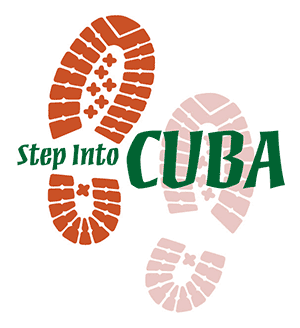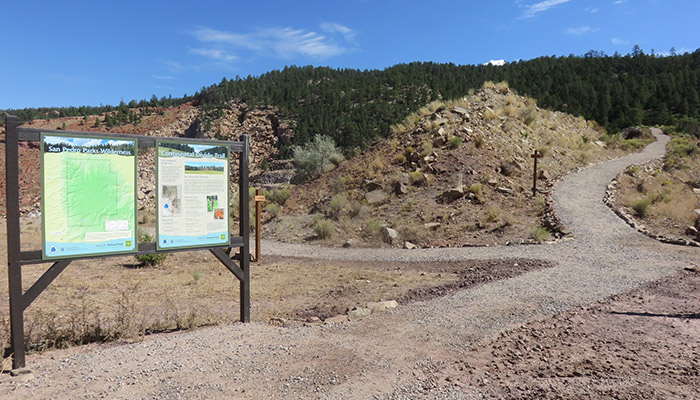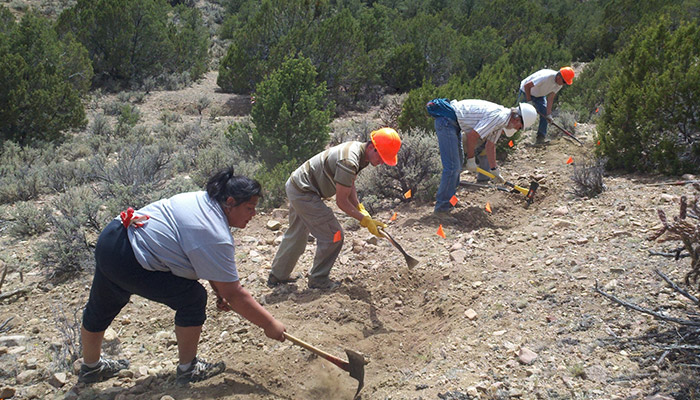Step Into Cuba
- Need: To increase physical activity and quality of life in rural Cuba, New Mexico.
- Intervention: Step Into Cuba works to make the community more pedestrian-friendly by creating and improving hiking trails and other places to walk.
- Results: This program has led to new or improved trails, sidewalks and crosswalks, lighting on streets, walking groups, and walking events, among other achievements.
Description
To promote increased physical activity in rural Cuba, New Mexico, the Step Into Cuba program improves the community's walkability and hiking trails and creates social support for walking.

The Step Into Cuba Alliance is a community partnership with representation from the Village of Cuba, Sandoval County, University of New Mexico Prevention Research Center (UNMPRC), New Mexico Department of Transportation, Santa Fe National Forest, U.S. Bureau of Land Management, Cuba Independent School District, Mid-Region Council of Governments, and Continental Divide Trail Coalition. The alliance is managed by the nonprofit Nacimiento Community Foundation.
The Step Into Cuba Alliance worked with the UNMPRC to design, implement, and study the program over a ten-year period. The Alliance has adapted evidence-based strategies taken from the Guide to Community Preventive Services to develop its various interventions.
Services offered
Program partners develop, improve, and maintain trails and public places to walk as well as sponsor community campaigns, walking events, informational materials, and other outreach.
Program coordinators also encouraged healthcare providers to counsel patients on introducing regular walking and other exercise in community settings.
A regional recreation guide and map with accompanying materials were developed and widely disseminated in print and electronically. Informational kiosks and signage were developed and installed in key locations.

Results
Step Into Cuba has led to new or improved trails, sidewalks and crosswalks, lighting on streets, walking groups, a shared-use agreement allowing community members to use trails on school property, wellness programs in schools, and published walking and hiking maps and guides.
The program has measured use of its park trail and documented a threefold or more increase in use following asphalt surfacing in 2018. On land donated by the Nacimiento Community Foundation for public open space, community volunteers and youth workers constructed a trail connecting Cuba to the nearest National Forest boundary. A Health Impact Assessment was conducted to complete a 12-mile gap in the Continental Divide National Scenic Trail through Cuba; the northbound limb of the new segment has been completed.
Many walkers who were interviewed by the UNMPRC report increased social connection. As one interviewee described it, "It is a double whammy. You feel better from walking, and you have some social interaction in a positive way."
Program coordinators disseminated lessons learned as part of consultation to a network of 30 other rural New Mexico communities. A video series and fact sheets were shared with many attempting to replicate successful approaches. Following the initial 10-year study, further adaptation of Step Into Cuba strategies was implemented by 10 eastern Navajo Nation Chapters through the UNMPRC-coordinated Healthy Places Healthy People program.
For more information about this program:
Davis, S.M., Cruz, T.H., & Kozoll, R.L. (2014). Health Impact Assessment, Physical Activity and Federal Lands Trail Policy. Health Behavior and Policy Review, 1(1), 82-95. Article Abstract
Kozoll, R., & Davis, S.M. (2012). Physical Activity Promotion in Rural America. In R.A. Crosby, M.L. Wendel, R.C. Vanderpool, & B.R. Casey (Eds.), Rural Populations and Health: Determinants, Disparities, and Solutions (pp. 287-301). Jossey-Bass.
Challenges
Leadership turnover in partnering organizations makes recruiting and engaging new leaders an ongoing challenge. Maintaining trails and trail enhancements requires ongoing prompting and recruitment of volunteer groups. The program required external funding to retain employed leadership, and when that funding was not available, it was a challenge relying on volunteer leadership.
Replication
Community mapping, walkability workshops, and local and external partnerships were often used to plan community trails and programs.
Program partners relied heavily on community volunteers.

Contact Information
Sally M. Davis, PhD, DirectorUniversity of New Mexico Prevention Research Center
Step Into Cuba
505.249.4321
sdavis@salud.unm.edu
Topics
Community engagement and volunteerism
· Physical activity
· Wellness, health promotion, and disease prevention
States served
New Mexico
Date added
January 14, 2025
Suggested citation: Rural Health Information Hub, 2025 . Step Into Cuba [online]. Rural Health Information Hub. Available at: https://www.ruralhealthinfo.org/project-examples/1150 [Accessed 8 November 2025]
Please contact the models and innovations contact directly for the most complete and current information about this program. Summaries of models and innovations are provided by RHIhub for your convenience. The programs described are not endorsed by RHIhub or by the Federal Office of Rural Health Policy. Each rural community should consider whether a particular project or approach is a good match for their community’s needs and capacity. While it is sometimes possible to adapt program components to match your resources, keep in mind that changes to the program design may impact results.
